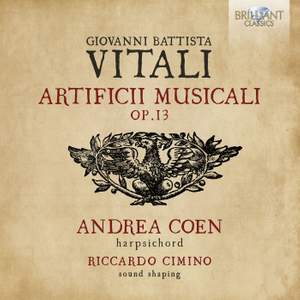Born in Bologna on 18 February 1632, Giovanni Battista Vitali (d. 1692) was one of the most outstanding composers of his generation. Rising to become sotto maestro di cappella at the court of the music-loving Duke Francesco II d’Este in 1674, the Italian’s output ranges from cantatas and oratorios to various instrumental works.
The Artificii Musicali Op.13 (1689) is one of the most comprehensive studies of counterpoint before Bach’s Die Kunst der Fuge and Musicalisches Opfer. The sixty pieces are an impressive display of contrapuntal technique for a variety of scorings, arranged in order of increasing difficulty. The collection contains canons for two to twelve voices, many incorporating additional compositional devices (e.g., canon 25. Canon à 2, at the fifth above, which ascends a step on repeating). Vitali also employs similar compositional devices in the non-canonic pieces in the collection – for example, a balletto in three different meters simultaneously, a passacaglia which modulates from E flat major to E major through the cycle of fifths, and another Balletto for two treble instruments which has one line written in G and the other in F.
The present recording is unique in that everything is performed only with one harpsichord, artfully multiplied by working in multitrack and using other sophisticated technological 'artifices' in order to do justice to the fascinating and complex nature of this work. For this the artist collaborated with one of the major Italian sound designers, Riccardo Cimino, who, besides being a composer and guitarist, owns a studio equipped with cutting-edge technologies of the highest level, including "ambisonics".
Andrea Coen is an organist, harpsichordist, and fortepianist, who has studied with such distinguished artists as Ton Koopman and Alan Curtis, and has collaborated with such figures as Christopher Hogwood and Monica Huggett. His recordings of Baroque and early-Classical keyboard repertoire for Brilliant Classics have attracted glowing reviews. Coen recorded the “Kleine Kammermusik” (BC 95683) and made the first complete recording of Telemann’s “100 Menuets” (BC 96249) and Telemann’s Fantasias (94228). According to MusicWeb International: ‘Coen, an experienced, insightful instrumentalist with a profound knowledge of historical performance practice and a sackful of important recordings under his belt, could make Telemann sound special even on a typewriter.’





